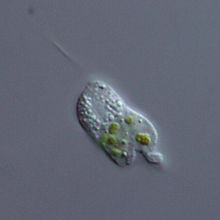- Cercomonadida
-
Cercomonads 
Cercomonas sp Scientific classification Domain: Eukaryota (unranked): Rhizaria Phylum: Cercozoa Class: Sarcomonadea Order: Cercomonadida
Poche, 1913Genera Cercomonadidae
Cercomonas
Helkesimastix
Heteromitidae
Heteromita
Protaspis
Allantion
Sainouron
Cholamonas
KatabiaCercomonads are small flagellates,[1] widespread in aqueous habitats and common in soils.[2]
Characteristics
The cells are generally around 10 μm in length, without any shell or covering. They produce filose pseudopods to capture bacteria, but do not use them for locomotion, which usually takes place by gliding along surfaces.
Most members have two flagella,[3] one directed forward and one trailing under the cell, inserted at right angles near its anterior. The nucleus is connected to the flagellar bases and accompanied by a characteristic paranuclear body.
Classification
Genetic studies place the cercomonads among the Cercozoa,[4] a diverse group of amoeboid and flagellate protozoans. They are divided into two families.
- The Heteromitidae tend to be relatively rigid, and produce only temporary pseudopods.
- The Cercomonadidae are more plastic, and when food supplies are plentiful may become amoeboid and even multinucleate.
The classification of genera and species continues to undergo revision. Some genera have been merged, like Cercomonas and Cercobodo, and some have been moved to other groups.
References
- ^ Mylnikov, A.P. and Karpov, S.A. (2004). "Review of diversity and taxonomy of cercomonads". Protistology 3 (4): 201–217. http://protistology.ifmo.ru/num3_4/mylnikov.pdf.
- ^ Karpov SA, Bass D, Mylnikov AP, Cavalier-Smith T (June 2006). "Molecular phylogeny of Cercomonadidae and kinetid patterns of Cercomonas and Eocercomonas gen. nov. (Cercomonadida, Cercozoa)". Protist 157 (2): 125–58. doi:10.1016/j.protis.2006.01.001. PMID 16647880. http://linkinghub.elsevier.com/retrieve/pii/S1434-4610(06)00022-8.
- ^ Bass, D.; Howe, A.; Mylnikov, A.; Vickerman, K.; Chao, E.; Edwards Smallbone, J.; Snell, J.; Cabral C, J. et al. (2009). "Phylogeny and Classification of Cercomonadida (Protozoa, Cercozoa): Cercomonas, Eocercomonas, Paracercomonas, and Cavernomonas gen. Nov". Protist 160 (4): 483–521. doi:10.1016/j.protis.2009.01.004. PMID 19589724.
- ^ Bass D, Richards TA, Matthai L, Marsh V, Cavalier-Smith T (2007). "DNA evidence for global dispersal and probable endemicity of protozoa". BMC Evol. Biol. 7: 162. doi:10.1186/1471-2148-7-162. PMC 2194784. PMID 17854485. http://www.biomedcentral.com/1471-2148/7/162.
Rhizaria Cercozoa FilosaImbricateaEuglyphida: Cyphoderiidae · Euglyphidae · Paulinellidae · Trinematidae · Thaumatomonadida: ThaumatomastigidaeThecofiloseaSpongomonadeaSpongomonas, RhipidodendronCercomonadidaCercomonadidae · Heteromitidae · SainouridaeReticulofilosaProteomyxideaGymnophryidae · Heliomorphidae · Desmothoracida · GymnosphaeridaChlorarachnion, Gymnochlora, Lotharella, Cryptochlora, BigelowiellaEndomyxaPhytomyxea, Vampyrellidae, Pseudospora, Ascetosporea: Paramyxea · Haplosporidia, Gromiidae, ReticulosidaRetaria Categories:- Cercozoa
- Flagellates
Wikimedia Foundation. 2010.
